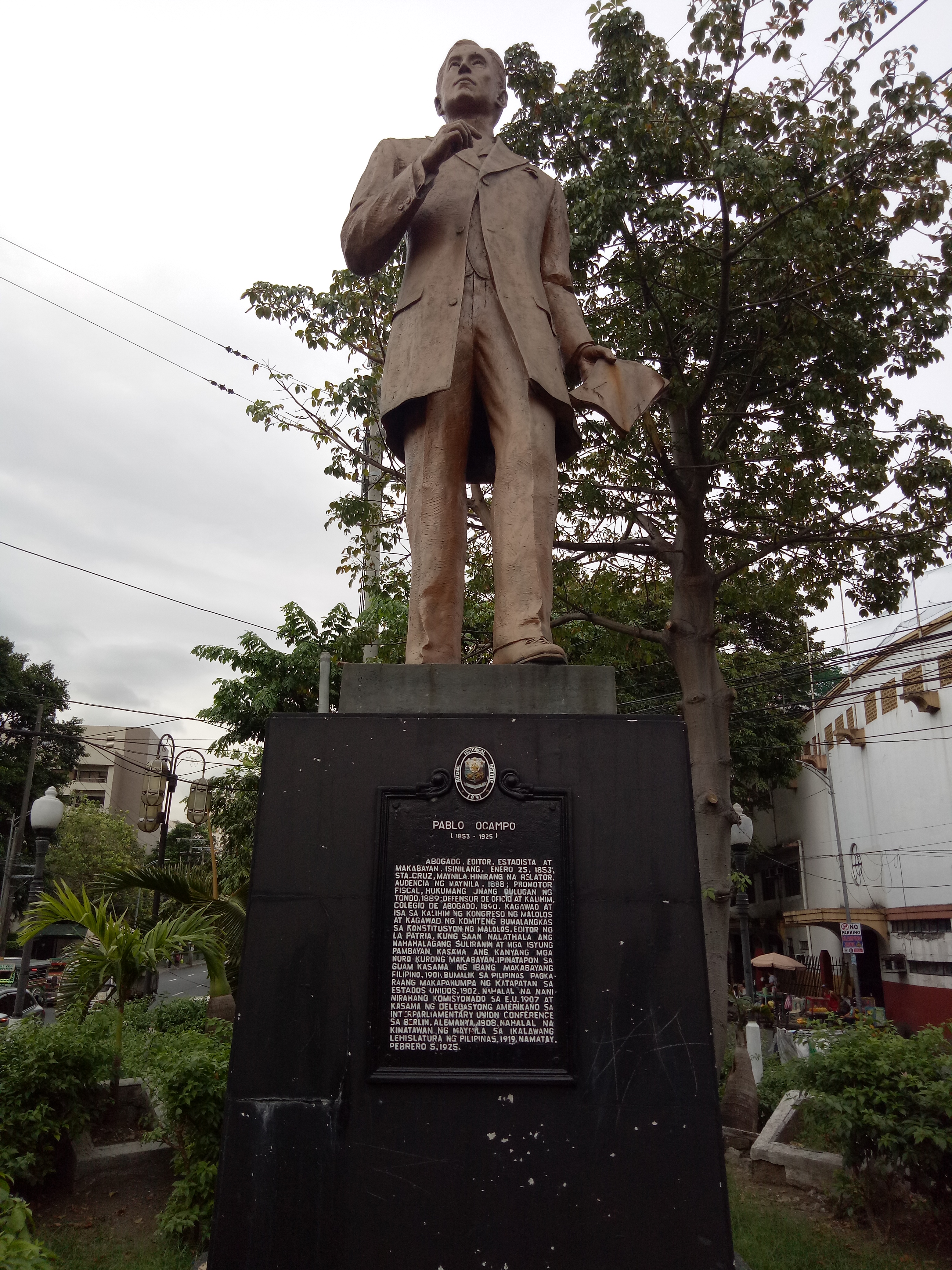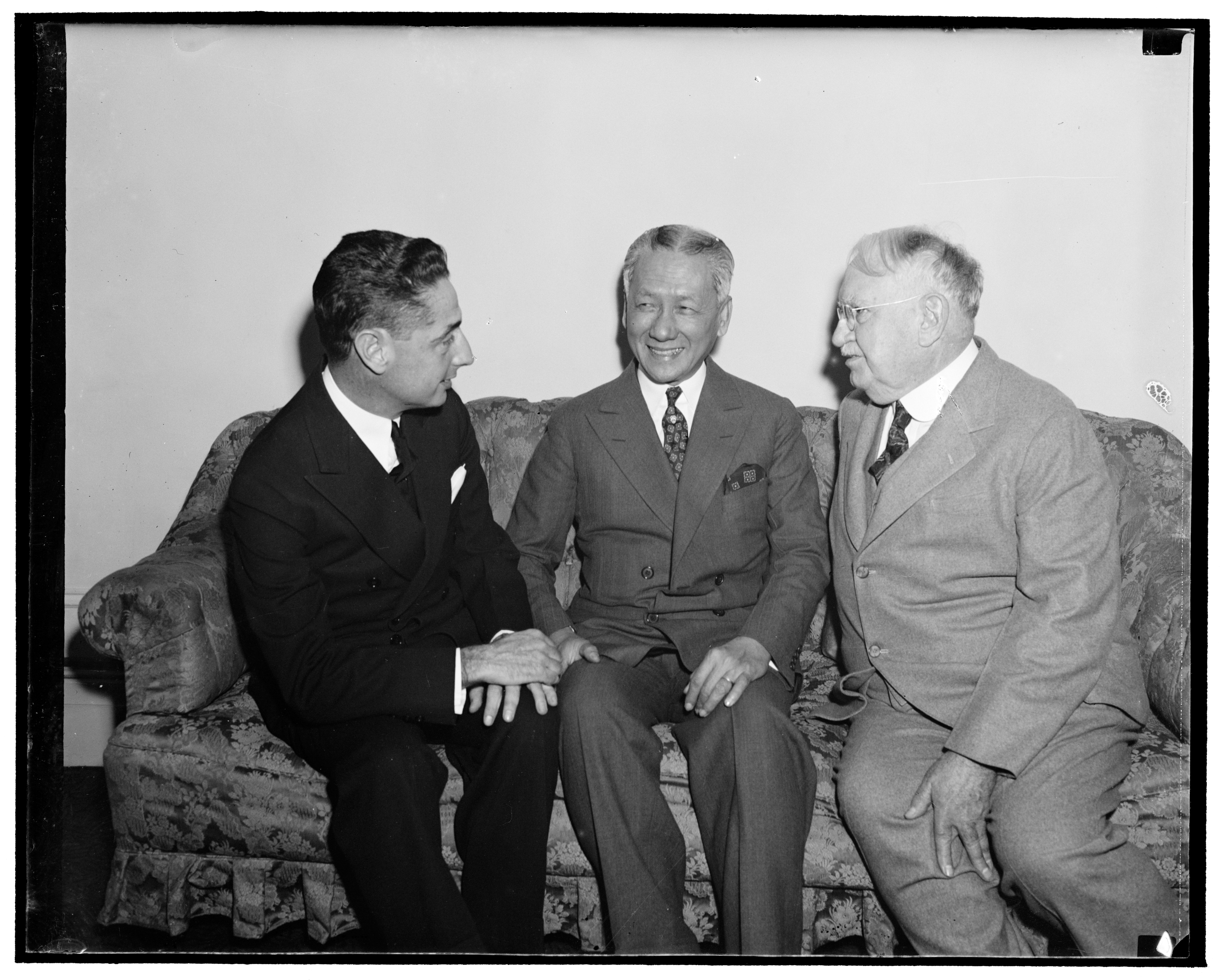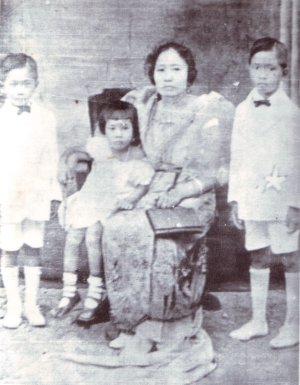|
Pablo Ocampo
Pablo de Leon Ocampo (born Pablo Ocampo y de León; January 25, 1853 – February 5, 1925) was a Filipino lawyer, nationalist, a member of the Malolos Congress, inaugural holder of the office of Resident Commissioner from the Philippine Islands to the United States Congress alongside Benito Legarda and a member of the 2nd Philippine Legislature. He gave his service to his country and helped to bring about the peaceful transition of the Philippines from being a colony of Spain for more than 300 years (1565 to 1898) to what will later become the American Commonwealth of the Philippines. Early life and education Ocampo was born in Quiapo, Manila, Quiapo, Manila, Spanish Philippines on January 25, 1853. His father was Andres Ocampo, a gobernadorcillo of Santa Cruz, Manila in the Spanish period, while his mother was Macaria de Leon. Ocampo spent his secondary school years in the Colegio de San Juan de Letran and went on to take up law at the University of Santo Tomas. He finished hi ... [...More Info...] [...Related Items...] OR: [Wikipedia] [Google] [Baidu] |
Resident Commissioner Of The Philippines
The resident commissioner of the Philippines () was a non-voting member of the United States House of Representatives sent by the Philippines from 1907 until its internationally recognized independence in 1946. It was similar to current non-voting members of Congress such as the resident commissioner of Puerto Rico and delegates from Washington, D.C., Guam, the Northern Mariana Islands and other territories of the United States. Like current non-voting members, resident commissioners could speak and otherwise participate in the business of the House, but did not have full voting rights. Two resident commissioners were sent until 1937, when after the establishment of the Commonwealth of the Philippines, the number was changed to one. History The Philippines was a United States territory from 13 August 1898 until Philippine independence was internationally recognized on 4 July 1946. The office was first created by the Philippine Organic Act of 1902, section 8 and re-authorize ... [...More Info...] [...Related Items...] OR: [Wikipedia] [Google] [Baidu] |
The Honourable
''The Honourable'' (British English) or ''The Honorable'' (American English; see spelling differences) (abbreviation: ''Hon.'', ''Hon'ble'', or variations) is an honorific style that is used as a prefix before the names or titles of certain people, usually with official governmental or diplomatic positions. Use by governments International diplomacy In international diplomatic relations, representatives of foreign states are often styled as ''The Honourable''. Deputy chiefs of mission, , consuls-general and consuls are always given the style. All heads of consular posts, whether they are honorary or career postholders, are accorded the style according to the State Department of the United States. However, the style ''Excellency'' instead of ''The Honourable'' is used for ambassadors and high commissioners. Africa The Congo In the Democratic Republic of the Congo, the prefix 'Honourable' or 'Hon.' is used for members of both chambers of the Parliament of the Democratic Repu ... [...More Info...] [...Related Items...] OR: [Wikipedia] [Google] [Baidu] |
Constituent Assembly
A constituent assembly (also known as a constitutional convention, constitutional congress, or constitutional assembly) is a body assembled for the purpose of drafting or revising a constitution. Members of a constituent assembly may be elected by Direct election, popular vote, drawn by sortition, appointed, or some combination of these methods. Assemblies are typically considered distinct from a regular legislature, although members of the legislature may compose a significant number or all of its members. As the fundamental document constituting a state, a constitution cannot normally be modified or amended by the state's normal legislative procedures in some jurisdictions; instead a constitutional convention or a constituent assembly, the rules for which are normally laid down in the constitution, must be set up. A constituent assembly is usually set up for its specific purpose, which it carries out in a relatively short time, after which the assembly is dissolved. A constituen ... [...More Info...] [...Related Items...] OR: [Wikipedia] [Google] [Baidu] |
Tondo, Manila
Tondo is a district located in Manila, Philippines. It is the largest in terms of area and population of Manila's sixteen districts, with a Census-estimated 631,313 people in 2015 and consists of two congressional districts. It is also the second most densely populated district in the city. Etymology The name Tondo can be derived from its Old Tagalog name, Tundun as inscribed in the Laguna Copperplate Inscription of 900 AD, the earliest native document found within the Philippines. Dutch anthropologist Antoon Postma, the first to translate the copperplate, believes the term ''tundun'' originated from the old Indian language Sanskrit, which was used alongside Old Malay as a language of politics and religion in the area at the time. Before this landmark discovery, several theories (however incorrect now) existed. Philippine National Artist Nick Joaquin once suggested that it might be a reference to a high ground ("tundok"). On the other hand, French linguist Jean-Paul Potet, s ... [...More Info...] [...Related Items...] OR: [Wikipedia] [Google] [Baidu] |
Our Lady Of Peace And Good Voyage
Our Lady of Peace and Good Voyage ( es, Nuestra Señora de la Paz y Buen Viaje; fil, Mahal na Birhen ng Kapayapaan at Mabuting Paglalakbay), also known as Our Lady of Antipolo and the Virgin of Antipolo ( fil, Birhen ng Antipolo), is a 17th-century Roman Catholic wooden image of the Blessed Virgin Mary venerated in the Philippines. This Black Madonna is enshrined in Antipolo Cathedral in the Sierra Madre mountains east of Metro Manila. The image was brought to the country by governor-general Juan Niño de Tabora from Mexico via the galleon ''El Almirante'' in 1626. His safe voyage across the Pacific Ocean was attributed to the image, which was given the title of "Our Lady of Peace and Good Voyage". It was substantiated later by six other successful voyages of the Manila-Acapulco Galleons with the image aboard as its patroness."Diocese of Anti ... [...More Info...] [...Related Items...] OR: [Wikipedia] [Google] [Baidu] |
Antipolo Cathedral
Antipolo Cathedral, formally known as the International Shrine of Our Lady of Peace and Good Voyage and the Immaculate Conception Parish, is a Roman Catholic cathedral located in Antipolo in the Philippines. It enshrines the Marian image of Our Lady of Peace and Good Voyage ( es, Nuestra Señora de la Paz y Buen Viaje), and is the seat of the Bishop of Antipolo. It is also the Immaculate Conception Parish and is referred to by locals as the "''Simbahan ng Antipolo''" (''Church'' of Antipolo). The shrine attracts millions of pilgrims annually, especially during the Pilgrimage Season which commences with the Alay Lakad from Quiapo Church on April 30 until the month of May. History The first missionaries of Antipolo were the Franciscans. The first church in Antipolo was built by the Society of Jesus under Rev. Juan de Salazar. The Jesuits administered the church from 1591 to 1768. The church was prepared for the image of Nuestra Señora dela Paz y Buen Viaje in 1632. However, the ... [...More Info...] [...Related Items...] OR: [Wikipedia] [Google] [Baidu] |
Ferdinand Marcos
Ferdinand Emmanuel Edralin Marcos Sr. ( , , ; September 11, 1917 – September 28, 1989) was a Filipino politician, lawyer, dictator, and kleptocrat who was the 10th president of the Philippines from 1965 to 1986. He ruled under martial law from 1972 until 1981 p. 189. and kept most of his martial law powers until he was deposed in 1986, branding his rule as "constitutional authoritarianism" under his Kilusang Bagong Lipunan (New Society Movement). One of the most controversial leaders of the 20th century, Marcos's rule was infamous for its corruption, extravagance, and brutality. Marcos gained political success by claiming to have been the "most decorated war hero in the Philippines", but many of his claims have been found to be false, with United States Army documents describing his wartime claims as "fraudulent" and "absurd". After World War II, he became a lawyer then served in the Philippine House of Representatives from 1949 to 1959 and the Philippine Senate from ... [...More Info...] [...Related Items...] OR: [Wikipedia] [Google] [Baidu] |
Francisco Santiago
Francisco Santiago Santiago (January 29, 1889 – September 28, 1947) was a Filipino musician, sometimes called ''The Father of Kundiman Art Song''. Life Santiago was born in Santa Maria, Bulacan, Philippines, to musically minded peasant parents, Felipe Santiago and Maria Santiago. In 1908, his first composition, ''Purita'', was dedicated to the first Carnival Queen, Pura Villanueva, who later married the distinguished scholar Teodoro Kalaw. He studied at the University of the Philippines (UP) Conservatory of Music, in its original campus in Manila, obtaining a degree in Piano in 1921, and a degree in Science and Composition in 1922. He went to the United States to pursue further education. He first obtained his master's degree at the American Conservatory of Music in June 1923, and finally a Doctorate degree at the Chicago Musical School in August 1924. He is the first Filipino musician to attain a doctorate degree. He became the director of the UP Conservatory of Musi ... [...More Info...] [...Related Items...] OR: [Wikipedia] [Google] [Baidu] |
San Juan De Letran College
The Colegio de San Juan de Letran, (transl: College of San Juan de Letran) also referred to by its acronym CSJL, is a private Catholic coeducational basic and higher education institution owned and run by the friars of the Order of Preachers in Intramuros, Manila, Philippines. It was founded in 1620. Colegio de San Juan de Letran has the distinction of being the oldest college in the Philippines and the oldest secondary institution in Asia. The school has produced Philippine presidents, revolutionary heroes, poets, legislators, members of the clergy, jurists, and it is also one of the only Philippine schools that has produced several Catholic saints who lived and studied on its campus. The school's patron saint is St. John the Baptist. The campus contains two statues, representing the two foremost alumni in the fields of secular and religious service: former Philippine President Manuel L. Quezon and Vietnamese Saint Vicente Liem de la Paz. Letran has programs in Business, Manag ... [...More Info...] [...Related Items...] OR: [Wikipedia] [Google] [Baidu] |
Colegio De San Juan De Letran
The Colegio de San Juan de Letran, (transl: College of San Juan de Letran) also referred to by its acronym CSJL, is a private Catholic coeducational basic and higher education institution owned and run by the friars of the Order of Preachers in Intramuros, Manila, Philippines. It was founded in 1620. Colegio de San Juan de Letran has the distinction of being the oldest college in the Philippines and the oldest secondary institution in Asia. The school has produced Philippine presidents, revolutionary heroes, poets, legislators, members of the clergy, jurists, and it is also one of the only Philippine schools that has produced several Catholic saints who lived and studied on its campus. The school's patron saint is St. John the Baptist. The campus contains two statues, representing the two foremost alumni in the fields of secular and religious service: former Philippine President Manuel L. Quezon and Vietnamese Saint Vicente Liem de la Paz. Letran has programs in Business, Manag ... [...More Info...] [...Related Items...] OR: [Wikipedia] [Google] [Baidu] |
Gobernadorcillo
The ''gobernadorcillo'' (, literally "little governor") was a municipal judge or governor in the Philippines during the Spanish colonial period, who carried out in a town the combined charges or responsibilities of leadership, economic, and judicial administration. The ''gobernadorcillo'' was the leader of a town or ''pueblo'' (people or population). In a coastal town, the ''gobernadorcillo'' functioned as a port captain. They were appointed through an exclusive nomination provided by the Spanish law. Their term of office lasted for two years. The position of a ''gobernadorcillo'' was honorary and mandatory in order to afford him those valid exemptions signified in the Philippine law. At the end of his biennial term he would enter and form part of the principalía, and was entitled to enjoy the honors and preeminence inherent to this state. This "mayor", who was at the same time " justice of the peace" and port captain, was directly responsible to the governor of the province in t ... [...More Info...] [...Related Items...] OR: [Wikipedia] [Google] [Baidu] |
Commonwealth Of The Philippines
The Commonwealth of the Philippines ( es, Commonwealth de Filipinas or ; tl, Komonwelt ng Pilipinas) was the administrative body that governed the Philippines from 1935 to 1946, aside from a period of exile in the Second World War from 1942 to 1945 when Japan occupied the country. It was established following the Tydings–McDuffie Act to replace the Insular Government, a United States territorial government.. The Commonwealth was designed as a transitional administration in preparation for the country's full achievement of independence. Its foreign affairs remained managed by the United States. During its more than a decade of existence, the Commonwealth had a strong executive and a Supreme Court. Its legislature, dominated by the Nacionalista Party, was at first unicameral, but later bicameral. In 1937, the government selected Tagalog – the language of Manila and its surrounding provinces – as the basis of the national language, although it would be many years befor ... [...More Info...] [...Related Items...] OR: [Wikipedia] [Google] [Baidu] |





.jpg)


.jpg)